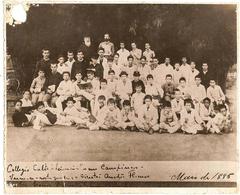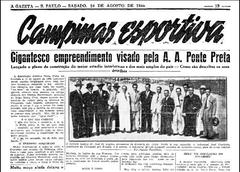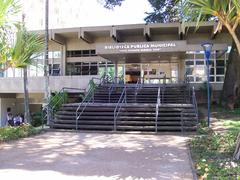Palácio Da Mogiana Visiting Hours, Tickets, and Campinas Historical Sites Guide
Date: 03/07/2025
Introduction: The Legacy of Palácio Da Mogiana in Campinas
Situated in the historic core of Campinas, Brazil, the Palácio Da Mogiana is a striking emblem of the city’s transformation during the railway boom of the late 19th and early 20th centuries. Built between 1891 and 1910 as the headquarters of the Companhia Mogiana de Estradas de Ferro, this landmark played a crucial role in the economic and urban development of Campinas, linking the São Paulo hinterland to major export routes (Minube; Campinas.com.br). With its eclectic-neoclassical architecture—characterized by grand façades, ornate cornices, and elegant interiors—the Palácio reflects the optimism of the era when railways fueled Brazil’s coffee-driven prosperity.
Though the Palácio Da Mogiana no longer operates as a public museum with regular visiting hours, its heritage status and preserved façade continue to attract history and architecture enthusiasts. Special events occasionally open its doors, while nearby attractions like Estação Cultura enrich the visitor experience within Campinas’s vibrant historical core (ipatrimônio; Correio RAC).
This guide provides practical visitor information—including current accessibility, ticketing, and local tips—alongside an in-depth look at the Palácio Da Mogiana’s history, architectural highlights, and enduring cultural significance. Whether you are traveling to Campinas, studying its history, or admiring its urban heritage, this resource will help you appreciate one of Brazil’s most notable railway-era landmarks (cidadeecultura.com; wikipedia).
Table of Contents
- Introduction
- Historical Context: Origins and Railway Era
- Architectural and Cultural Significance
- Adaptive Reuse and Preservation
- Visiting Hours, Tickets, and Accessibility
- Nearby Attractions and Suggested Itineraries
- Practical Tips for Visitors
- Frequently Asked Questions (FAQ)
- Conclusion
- References
Historical Context: Origins and the Railway Era
The Palácio Da Mogiana emerged during a period of profound change in Campinas. The arrival of the railway, spearheaded by the Companhia Mogiana de Estradas de Ferro, transformed the city from an agricultural center into a bustling urban hub. The palace’s construction, strategically located on Rua Visconde do Rio Branco near other major avenues, underscored Campinas’s pivotal role in São Paulo’s coffee trade and industrialization (Minube).
The railway’s growth fueled economic expansion, with the Palácio serving as the nerve center for management and operations. Over time, the building witnessed the city’s urban evolution, even enduring the loss of one wing to street widening projects as the city modernized.
Architectural and Cultural Significance
Eclectic Neoclassical Style
The Palácio Da Mogiana is a prime example of late 19th- and early 20th-century eclecticism, blending neoclassical symmetry with ornate Renaissance-inspired decoration. The façade features balanced proportions, elaborate cornices, and decorative moldings, while the interiors boast high ceilings, intricate plasterwork, and the iconic spiral staircase. The Salão Nobre (Noble Hall) stands out for its scale and ornamentation, reflecting the building’s institutional grandeur (Campinas.com.br; Minube).
Cultural Symbolism
As a symbol of Campinas’ golden age, the Palácio Da Mogiana encapsulates the city’s optimism during the coffee and railway boom. Its survival and restoration represent local pride and a commitment to heritage preservation. Over the decades, the building has adapted to changing needs, hosting cultural events and serving as headquarters for municipal institutions.
Adaptive Reuse and Preservation
After decades of neglect, a comprehensive restoration in 2009 revitalized the Palácio, restoring original colors and details based on historic photographs. The building now houses municipal offices such as the Centro Público de Apoio ao Trabalhador (CPAT) and the Câmara dos Dirigentes Lojistas de Campinas (CDL). Although the third floor remains closed due to structural issues, ongoing maintenance by organizations like ACIC ensures the site’s stability (ipatrimônio; Correio RAC).
The Palácio’s restoration and adaptive reuse serve as a model for balancing heritage conservation with contemporary urban needs.
Visiting Hours, Tickets, and Accessibility
Visiting Hours & Access
- Public Access: As of July 2025, the Palácio Da Mogiana does not function as a full-time museum or cultural center. Public access is generally limited to municipal office hours and special events. There are no regular tours or ticketed exhibitions.
- Office Hours: Monday to Friday, 9:00 AM to 6:00 PM; Saturday, 9:00 AM to 1:00 PM; closed Sundays. These hours reflect access to municipal offices, not the heritage areas.
Tickets
- Entry Fee: There is no charge to admire the exterior or to visit municipal service areas within the building. Special events or tours, when available, may require advance booking or a fee.
Accessibility
- Mobility: Accessibility is limited due to the building’s historic design. There are steps and narrow corridors, and not all areas are adapted for visitors with reduced mobility. Contacting municipal offices ahead of a visit is recommended for specific needs.
Visitor Facilities
- The Palácio does not offer dedicated visitor amenities such as restrooms, cafés, or gift shops. However, its central location provides easy access to restaurants, cafés, and other services nearby (Wild Trips).
Photography
- Exterior photography is encouraged. Interior photography may be restricted, especially in functioning office areas or during events.
Nearby Attractions and Suggested Itineraries
Key Heritage Sites
- Estação Cultura: Former central railway station, now a cultural center with exhibitions and performances.
- Museu de Arte Contemporânea de Campinas (MACC): Museum featuring a diverse art collection.
- Jockey Club Campineiro: Architectural landmark from 1925.
- Bosque dos Jequitibás: Urban park ideal for leisure and nature walks (Wild Trips).
Suggested Itinerary
- Morning: Stroll past the Palácio Da Mogiana and Estação Cultura.
- Lunch: Nearby cafés or Mercado Municipal.
- Afternoon: Explore MACC and Bosque dos Jequitibás.
Practical Tips for Visitors
- Best Time to Visit: The dry season (May–September) offers mild temperatures and is ideal for walking tours (Wild Trips; trek.zone).
- Safety: The central area is generally safe during business hours; exercise standard precautions and avoid deserted areas after dusk.
- Language: Portuguese is the primary language; having a translation app or phrasebook is helpful.
- Etiquette: As the palace houses municipal offices, dress respectfully and maintain quiet in office areas.
Frequently Asked Questions (FAQ)
Q: Is Palácio Da Mogiana open to visitors?
A: The palace is not open as a museum; access is limited to municipal office hours and special cultural events.
Q: Is there an entry fee?
A: No fee to view the exterior or access municipal offices. Fees may apply for special tours or events.
Q: Are guided tours available?
A: Regular tours are not offered, but occasional walking tours of the historical core may include the palace exterior. Check with the tourism office for updates.
Q: Is the site accessible for people with disabilities?
A: Accessibility is limited due to the historic structure. Contact municipal offices in advance for assistance.
Q: Can I take photographs?
A: Exterior photography is allowed; interior photography is generally restricted to special events.
Conclusion
The Palácio Da Mogiana is a cornerstone of Campinas’s historical and architectural heritage. While interior access is limited, its grand façade and location within the city’s vibrant historic core make it a highlight for cultural travelers. By exploring the palace and nearby attractions, visitors can immerse themselves in Campinas’s golden era of railway-driven prosperity, architecture, and urban identity. Stay informed about public openings and events by consulting official city resources and leveraging digital tools like the Audiala app for the latest updates.
References
- Campinas.com.br
- Minube
- ipatrimônio
- Correio RAC
- cidadeecultura.com
- wikipedia
- Wild Trips
- visitsights.com
- horacampinas.com.br
- triplyzer.com
- trek.zone
- artsandculture.google.com





